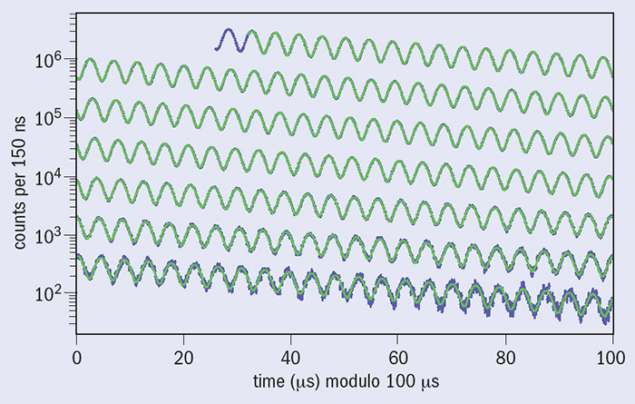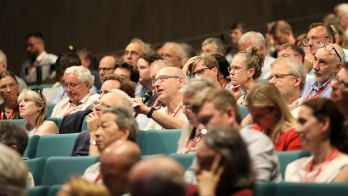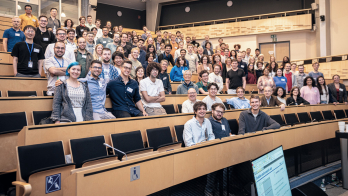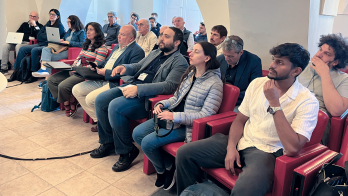The Brookhaven muon storage ring is being re-assembled at Fermilab and prepared for a new round of measurements.

Image credit: Fermilab
In March 2001, the Brookhaven g-2 storage ring was retired, after producing the world’s best measurements of the muon’s anomalous magnetic moment, aμ = (g-2)/2. However, the experiment produced a cliffhanger: the experimental result differed by 3–4σ from the theoretical prediction for aμ, hinting potentially at the presence of new physics beyond the Standard Model.
Now, a new experiment to measure aμ is under construction at Fermilab, with the goal of confirming or refuting the evidence produced at Brookhaven. The new Muon g-2 collaboration will reuse Brookhaven’s storage-ring magnet and several of its subsystems to do the experiment with a precision four times better. In the summer of 2013, a company specializing in moving large objects brought the centrepiece of the storage-ring system – a 14-m-diameter electromagnet – from Brookhaven to Fermilab (CERN Courier July/August 2013 p11). Then, during summer this year, the next milestone was achieved as re-assembly of the storage ring began in the newly completed MC-1 building at Fermilab (figures 1 and 2).

Image credit: Fermilab
The superconducting magnet – the design led by Gordon Danby, Hiromi Hirabayashi and Akira Yamamoto, beginning in the late 1980s – provides a highly uniform, essentially pure, 1.45-T dipole field throughout its 44.7-m circumference (Danby et al. 2001). The storage-ring system includes a unique superconducting inflector magnet that enables bunches of 3.1 GeV/cmuons produced in a pion-decay channel to enter the magnetic-field region along a nearly field-free path. A pulsed kicker applies a magnetic deflection to redirect the incoming muons into the ring’s storage volume. A set of four electric quadrupoles provide vertical focusing without perturbing the critical uniform magnetic field. This unique system of devices allows direct injection of the muons – a breakthrough compared with previous g-2 experiments – allowing the Brookhaven experiment to improve the precision by a factor of 14, compared with the series of experiments that took place at CERN in the mid 1970s. The final result from the Brookhaven E821 experiment is aμ = 116 592 089 (63) × 10–11 – a precision of 0.54 ppm – where the error is dominated by statistics, not systematics (Muon g-2 Collaboration 2006).

Image credits: Brookhaven National Laboratory
To measure g-2, polarized muons are injected into the storage ring and their spin evolution is tracked as they circulate. If g were exactly equal to 2, the muon spin would remain in the direction of its momentum. For g > 2, the spin advances, or precesses, proportionally to the anomalous part of the magnetic moment. In this particular storage ring, on every 29.4 revolutions, the spin orientation advances by one turn compared with the momentum. Parity violation in the weak decay of the muon then serves as the spin analyser. The higher-energy electrons in the μ → eνν decay chain are emitted preferentially in the direction of the muon spin at the time of the decay. Because the electrons have lower momentum compared with the muons, they curl to the inside of the storage ring, where they can be detected. Figure 3 shows a histogram of the arrival time vs the time after injection for the higher-energy electrons, measured when they struck one of 24 symmetrically placed electromagnetic calorimeters located just to the inside of the storage volume in the E821 experiment. The characteristic anomalous precession frequency is clearly visible. When combined with the integrated magnetic field that is measured using pulsed proton NMR, the ratio of these quantities – precession frequency to field – leads directly to the quoted result for g-2.

The g-2 measurement tests the completeness of the Standard Model, because aμ arises from quantum fluctuations, as figure 4 illustrates. The theory must account for the quantum fluctuation effects from all known Standard Model particles that influence the muon’s magnetic moment. If something is left out, or there is a contribution from new physics, the theory would not match the experiment. While the contributions from QED and the weak interaction are well known, those from hadronic terms drive the overall theoretical uncertainty of about 0.46 ppm. The largest uncertainty comes from hadronic vacuum-polarization contributions. They can be determined directly from cross-section measurements at e+e– colliders, and vigorous programmes are underway in Novosibirsk, Beijing and Frascati to improve these measurements. More difficult to assess, although much smaller in magnitude, is the (α/π)3 hadronic “light-by-light” diagram. However, a recent dedicated workshop reports significant progress and plans to improve this situation, including progress in lattice-gauge calculations (Benayoun et al. 2014).
The next steps

The Brookhaven measurement differs from the prediction of the Standard Model by roughly 3–4σ, depending on the details of the hadronic contribution used in the comparison (Blum et al. 2013). While the present comparison is tantalizing, it does not meet the 5σ standard required for a discovery. Nevertheless, many theorists have speculated on what might be implied if it holds up to further scrutiny. Dominant themes include low-energy supersymmetry, dark gauge bosons, Randall–Sundrum models and others with large extra dimensions, to name a few. The impact of the result – whether it remains large and significant, or in the end agrees with the Standard Model – will constrain many theories of new physics.
To push further requires “more muons”. Following the completion of E821, a number of ideas were considered, but the winning concept came from a clever reuse of the Fermilab accelerator complex – in particular, much of the antiproton production facility – to produce a rapidly cycling injection of a pure, high-intensity muon beam, with nearly 100% polarization, into the storage ring. The plan, now part of a more global “Muon Campus” concept that includes the muon-to-electron search experiment (Mu2e), will result in a 20-fold increase in statistics compared with Brookhaven. The only obstacle was that the specialized storage-ring system was in New York and had not been powered for more than a decade. So, how to move it? And, once moved, would it still work? The delicate transcontinental move – by lorry, barge across sea and along river, and finally again by lorry – to deliver the 14-m-diameter superconducting coils to the Fermilab site enjoyed much publicity. With far less fanfare, 50 lorries hauled 650 tonnes of steel and other equipment westward.

The new Muon g-2 experiment at Fermilab, also known as E989, is now a mature effort. The collaboration of 36 institutions from eight countries will use or refurbish many of the components from the past. Nevertheless, much is totally new. With a higher expected beam rate, more rapid filling of the ring, and even more demanding goals in systematic uncertainties, the collaboration has had to devise improved instrumentation. The ring kicker-system will be entirely new, optimized to give a precise kick on the first turn only, to increase the storage fraction. The magnetic field will be even more carefully prepared and monitored. The detectors and electronics are entirely new, and a state-of-the-art calibration system will ensure critical performance stability throughout the long data-taking periods. New in situ trackers will provide unprecedented information on the stored beam. The first physics data-taking is expected in early 2017. The next critical milestone will be the cooling of the superconducting coils and powering of the storage-ring magnet, which is expected by spring 2015.
Further reading
M Benayoun et al. 2014 arXiv:1407.4021.
T Blum et al. 2013 arXiv:1311.2198.
G T Danby et al. 2001 Nucl. Instrum. Meth. A457 151.
Muon (g-2) Collaboration, G W Bennett et al. 2006 Phys. Rev. D 73 072003.








2 Comments